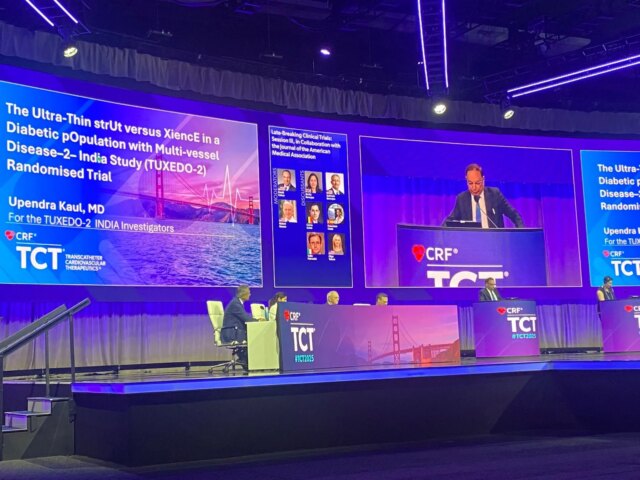San Francisco, Oct 30: A new multicenter study presented at TCT 2025, the world’s leading scientific symposium on interventional cardiology, has found that next-generation ultrathin drug-eluting stents are both safe and effective in diabetic patients with multivessel coronary artery disease (MVD) — a group often considered for bypass surgery.
The TUXEDO-2 trial compared outcomes of percutaneous coronary intervention (PCI) using two contemporary drug-eluting stents: a biodegradable polymer-coated sirolimus-eluting stent (BP-SES) and a durable-polymer everolimus-eluting stent (DP-EES).
Conducted across multiple centers in India, the prospective, open-label, randomized trial enrolled 1,800 patients with diabetes and multivessel disease. Participants were randomized equally to receive either BP-SES (N=901) or DP-EES (N=899), using modern PCI techniques such as intravascular imaging and physiology when feasible, alongside guideline-based medical treatment.
The mean age of participants was 60.3 years, and 28% were women. Nearly all patients (99.6%) had type 2 diabetes, with a mean duration of 5.9 years, and 24.2% were on insulin therapy. Triple-vessel disease was present in approximately 85% of patients in both groups.
Strong and Safe Results
The study reported excellent angiographic and procedural success rates (99.7%) in both groups, with very few complications (1.09% vs. 1.00%, p=0.77).
At one year, BP-SES was noninferior to DP-EES for the primary endpoint of target lesion failure (cardiac death, target-vessel myocardial infarction [TV-MI], or ischemia-driven target-lesion revascularization [ID-TLR]), with rates of 7.92% for BP-SES versus 8.75% for DP-EES (p non-inferiority = 0.005).
Rates of cardiac death (3.56% vs. 3.36%, HR: 1.07, 95% CI: 0.65–1.76, p=0.80), TV-MI (6.61% vs. 7.54%, HR: 0.86, 95% CI: 0.60–1.22, p=0.40), and ID-TLR (0.82% vs. 1.07%, HR: 0.67, 95% CI: 0.24–1.88, p=0.44) were similar between groups at one year.
No significant differences were seen in secondary endpoints, including non-fatal myocardial infarction, stent thrombosis, or major adverse cardiovascular events.
Expert Reaction
“Our study found that PCI was very safe with a low rate of repeat procedures and stent thrombosis even in a complex patient population of diabetics,” said Upendra Kaul, MD, Chairman of Cardiology and Dean of Academics and Research at Batra Hospital and Medical Research Center, New Delhi, and Director of Gauri Kaul Foundation and affiliated centers in Jammu and Kashmir.
“These results should have a positive impact on treatment options and patient outcomes for these high-risk patients,” he added.
Dr Kaul emphasized that the findings challenge long-held assumptions that diabetic patients with multivessel disease are better served by bypass surgery rather than PCI. “With advances in stent design — including thinner struts, improved polymers, and refined drug delivery systems — we’re seeing excellent results even in complex diabetic cases,” he said.
Implications for Clinical Practice
Clinical outcomes of PCI in diabetic patients with multivessel disease have historically been suboptimal. However, the TUXEDO-2 results suggest that newer-generation biodegradable polymer stents may offer outcomes comparable to established durable-polymer devices, expanding treatment options for diabetic populations.
Researchers said the low rates of restenosis, stent thrombosis, and myocardial infarction demonstrate the significant impact of design evolution in drug-eluting stent technology.
The study was funded by Sahajanand Medical Technologies Pvt Ltd, and Dr Kaul reported no financial disclosures.
Presentation and Context
The results were presented on Tuesday, October 28, 2025, at 12:12 p.m. PT in the Main Arena (Hall A, Exhibition Level, Moscone South) at the Moscone Center, San Francisco, during TCT 2025, the annual scientific symposium of the Cardiovascular Research Foundation (CRF).
TCT is recognized globally as the premier educational meeting in interventional cardiovascular medicine, featuring cutting-edge clinical trials, expert-led discussions, and innovations that shape the future of patient care.








